A walk on a summer’s evening.
Honey bee on hogweed. They appear to get very little pollen from these flowers, but instead swish their proboscis enthusiastically about in the nectar like a watercolour artist swirling their brush. I recommend Theresa Green’s post Hogweed days to find out more about this plant, including why its flowers mimic the smell of pigs!
And this beetle likes them too. I was surprised when the beetle suddenly took off and flew away, I got the photo just in time. Doesn’t its bum look like it could be its face?
A pretty pink version.
An important flower has come out. When you’re walking around on shortish grass, tread carefully. For there might be a delicate bee hidden in a clover flower. Can you see her beady eyes below?
Clover honey is one of my all-time favourite honeys. Elizabeth Gowing describes it in her Little Book of Honey as “sweet and light, with a citrus tang which changes to a sourish aftertaste that stops it being sickly to eat”.
Red clover is very popular with bumble bees but not honey bees, as their tongues are too short. Both bumbles and honey bees love white clover.
One of the beekeepers at the apiary today told me that the local bees were going absolutely crazy about the blackberry bramble bush at his allotment, so much so that passers by were getting afraid. It has been around 26C today – a real treat and about as hot as it ever gets here – and sun-loving plants will be excreting more nectar than usual.
A nectar flow is on! These photos were taken last Sunday, on a nice but less intensely hot day.
The thistles are favourites too. In The Little Book of Honey Elizabeth Gowing also tries thistle honey, which she says is “fragrant, spicy, reminiscent of… wait a minute – this honey really does taste like geraniums. My mind boggles; so what would geranium honey taste of?”
EDIT: identified by standingoutinmyfield in her comment below as a Canada thistle.
These flowers were much taller than me. They reminded me of fireworks going off against the sky.
EDIT: identified by standingoutinmyfield in her comment below as likely to be hemlock.
Being out in the sunshine makes me happy. And the bees too.
The next flowers to come along in the park during August will be rosebay willow-herb and ragwort. I’m gradually getting to know my local wild flowers, which I never knew much about before the bees came into my life.
Hope the weather’s good where you are, not too cold and not too hot, not too rainy but not too dry… if that’s possible.

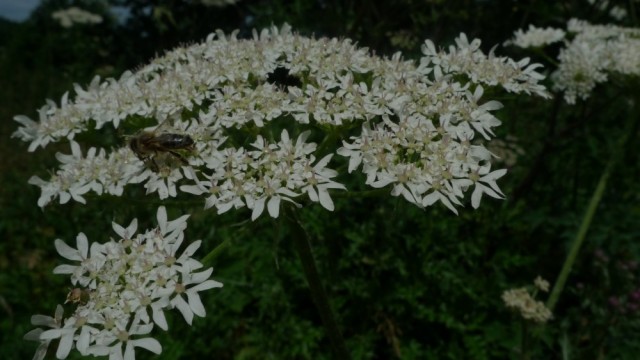
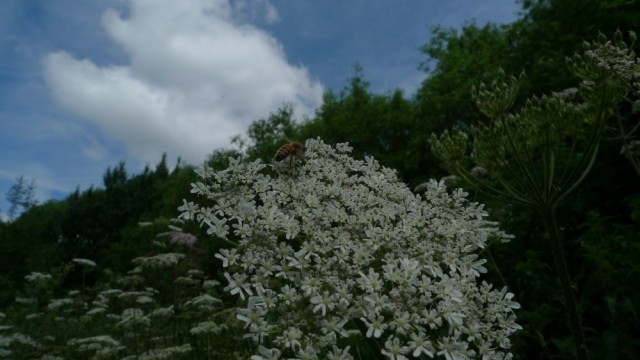
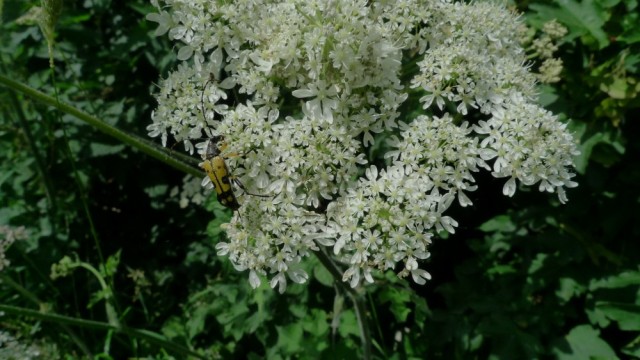
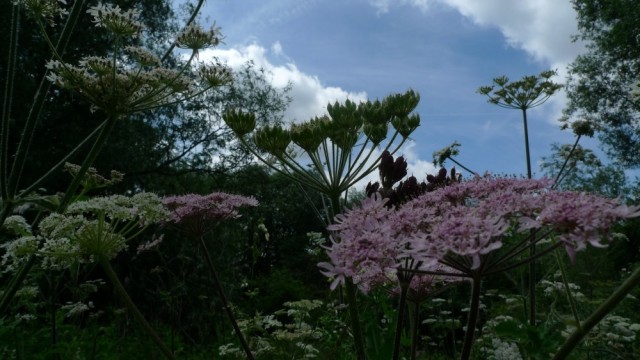

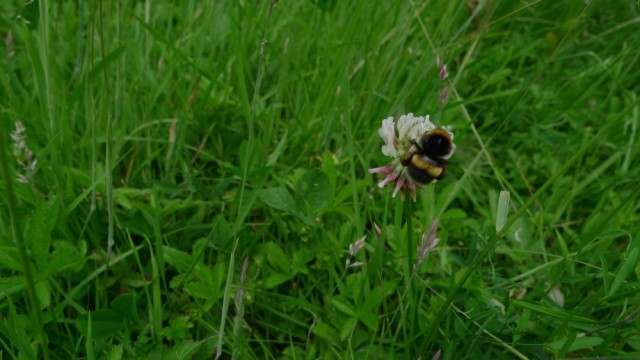
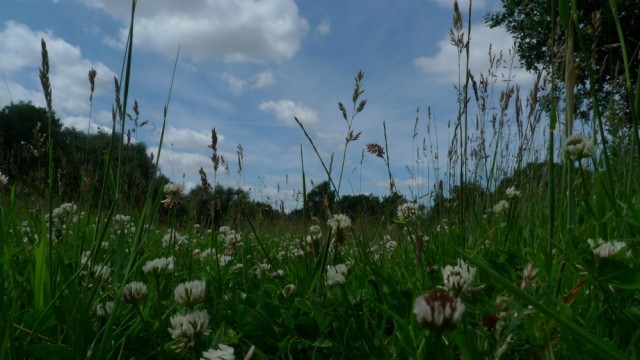
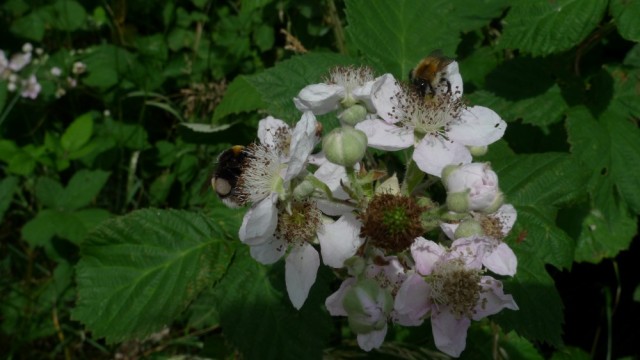

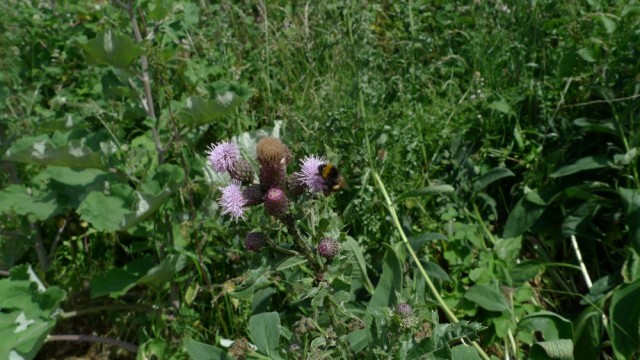
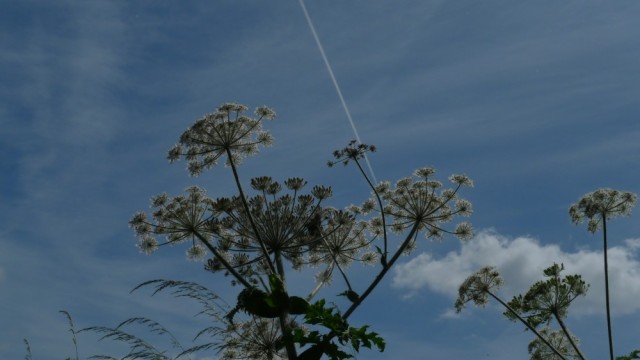
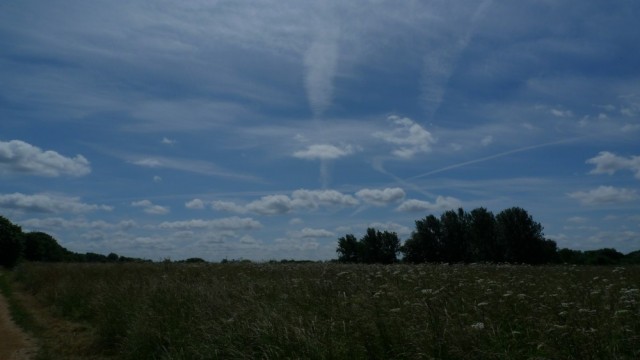
The other day when I was mowing the lawn, I had to stand and wait for a bee to finish on a clover before I mowed it over.
The first and (second to) last photos definitely in the family Apiaceae, maybe Aegopodium for the first? Not sure about that, but the last one definitely seems like a hemlock. And that’s canada thistle.
LikeLike
I’m glad there are people like you who notice the bees in the clover.
Thanks for the flower id’s. I had no idea that such a deadly plant lurked nearby! How much hemlock does a human have to ingest to cause poisoning, do you know?
LikeLike
Well, there are several species of hemlock it could be and I’m not sure which one. They are all…um…not good for you to eat. For Oenanthe, “one root is sufficient to kill a cow”, On the other hand, Cicuta grows very very tall, so that could be it…although the leaves don’t look right…Cicuta causes seizures following ingestion. Then there is Conium maculatum, which is the “poison hemlock” that was used for execution. “6-8 fresh leaves may be fatal”
LikeLike
Flowers, bees and sunshine – it doesn’t get better.
LikeLike
No, it really doesn’t! Especially with a glass of Pimms in the hand to sip whilst watching the bees go by.
LikeLike
Love to see the bees enjoying the blooms.
LikeLike
One of the joys of summer 🙂
LikeLike
Blackberry and clover are happening here too. We (the poetic ‘we’, my wife mows the lawns 🙂 mow paths now because for some odd reason, like maybe we planted clover a few years back and forgot about it…? That clover is coming on strong (and so are the bees) So if we need an excuse NOT to mow, we’ll just blame it on the bees. The paths will have to suffice during the nectar flow.
LikeLike
I like the idea of the paths, cute!
LikeLike
I have seen the bees in busy delight about blackberry flowers, and captured plenty of great photographs of them last week.
LikeLike
Fantastic. There will be a great blackberry crop this autumn.
LikeLike
Lovely summery post, lovely bees, but particularly loving that beetle. You’re observation about its bum looking like its face is a strategy employed by a lot of insects that hope a predator might be equally confused- they may survive losing a bit of tail, but probably not their head!
LikeLike
Wondered if that might be the case! I must try and take more photos of beetles, they seem to be popular!
LikeLike
Your beetle doesn’t have a common name, poor thing, but scientifically is ‘strangalia maculata’. I’m sure that if I get to see one up here I won’t get past thinking of it as the ‘bum-faced beetle’!
LikeLike
The ‘bum-faced beetle’ could perhaps become its common name?! I quite like its scientific name too. Thanks for identifying it for me.
LikeLike
Pingback: The hills are alive with the sound of …… bees! | Philip Strange Science Writing
Pingback: Hogweed days | everyday nature trails
Last year I just didn’t get round to mowing my back lawn and found that the following flowers had chance to come up and flower. Dandelion, clover and meadow vetch! The small lawn area seemed to attract every bumble bee in the area! I was a little sad that I didn’t see any honey bees (as I don’t have any of my hives in my small garden, but that changed when I brought two small swarms home to isolate them from my own hives until I could be sure they were healthy!
This year I cut the grass early and then left it and am pretty pleased with the resulting ‘natural’ wild flower meadow (very small).
LikeLike
I always see more bumbles on the clover than honey bees. Your little meadow sounds very pretty.
LikeLike